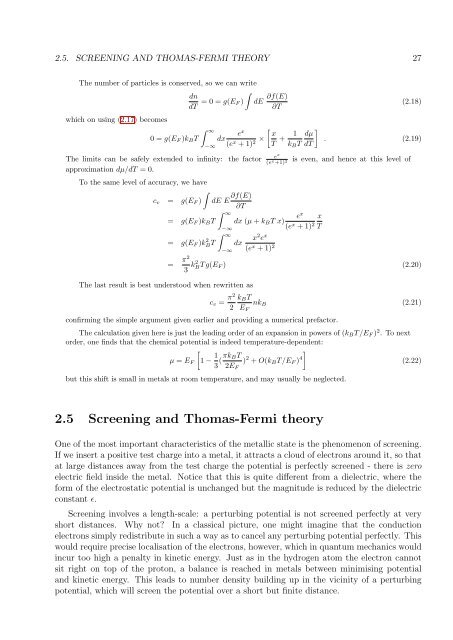Set of supplementary notes.
Set of supplementary notes.
Set of supplementary notes.
You also want an ePaper? Increase the reach of your titles
YUMPU automatically turns print PDFs into web optimized ePapers that Google loves.
2.5. SCREENING AND THOMAS-FERMI THEORY 27<br />
The number <strong>of</strong> particles is conserved, so we can write<br />
∫<br />
dn<br />
dT = 0 = g(E F ) dE ∂f(E)<br />
∂T<br />
which on using (2.17) becomes<br />
0 = g(E F )k B T<br />
∫ ∞<br />
−∞<br />
The limits can be safely extended to infinity: the factor<br />
approximation dµ/dT = 0.<br />
To the same level <strong>of</strong> accuracy, we have<br />
∫<br />
c v = g(E F ) dE E ∂f(E)<br />
∂T<br />
= g(E F )k B T<br />
= g(E F )k 2 BT<br />
e x [ x<br />
dx<br />
(e x + 1) 2 × T + 1 ]<br />
dµ<br />
k B T dT<br />
∫ ∞<br />
−∞<br />
∫ ∞<br />
−∞<br />
The last result is best understood when rewritten as<br />
(2.18)<br />
. (2.19)<br />
e x<br />
(e x +1) 2 is even, and hence at this level <strong>of</strong><br />
e x<br />
x<br />
dx (µ + k B T x)<br />
(e x + 1) 2 T<br />
dx<br />
x 2 e x<br />
(e x + 1) 2<br />
= π2<br />
3 k2 BT g(E F ) (2.20)<br />
c v = π2<br />
2<br />
k B T<br />
E F<br />
nk B (2.21)<br />
confirming the simple argument given earlier and providing a numerical prefactor.<br />
The calculation given here is just the leading order <strong>of</strong> an expansion in powers <strong>of</strong> (k B T/E F ) 2 . To next<br />
order, one finds that the chemical potential is indeed temperature-dependent:<br />
[<br />
µ = E F 1 − 1 ]<br />
3 (πk BT<br />
) 2 + O(k B T/E F ) 4 (2.22)<br />
2E F<br />
but this shift is small in metals at room temperature, and may usually be neglected.<br />
2.5 Screening and Thomas-Fermi theory<br />
One <strong>of</strong> the most important characteristics <strong>of</strong> the metallic state is the phenomenon <strong>of</strong> screening.<br />
If we insert a positive test charge into a metal, it attracts a cloud <strong>of</strong> electrons around it, so that<br />
at large distances away from the test charge the potential is perfectly screened - there is zero<br />
electric field inside the metal. Notice that this is quite different from a dielectric, where the<br />
form <strong>of</strong> the electrostatic potential is unchanged but the magnitude is reduced by the dielectric<br />
constant ɛ.<br />
Screening involves a length-scale: a perturbing potential is not screened perfectly at very<br />
short distances. Why not In a classical picture, one might imagine that the conduction<br />
electrons simply redistribute in such a way as to cancel any perturbing potential perfectly. This<br />
would require precise localisation <strong>of</strong> the electrons, however, which in quantum mechanics would<br />
incur too high a penalty in kinetic energy. Just as in the hydrogen atom the electron cannot<br />
sit right on top <strong>of</strong> the proton, a balance is reached in metals between minimising potential<br />
and kinetic energy. This leads to number density building up in the vicinity <strong>of</strong> a perturbing<br />
potential, which will screen the potential over a short but finite distance.








